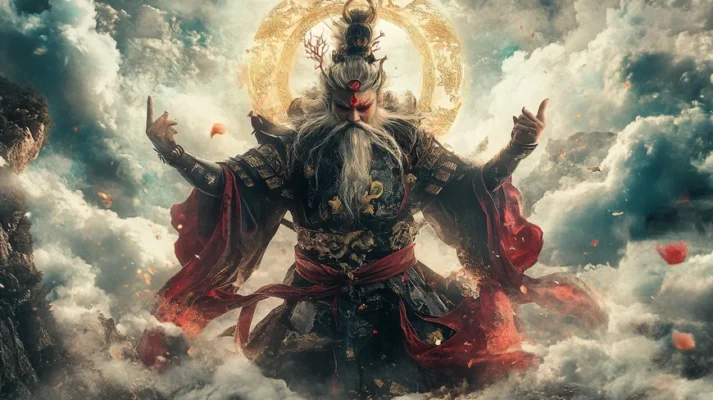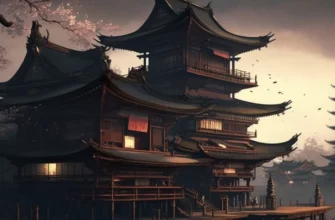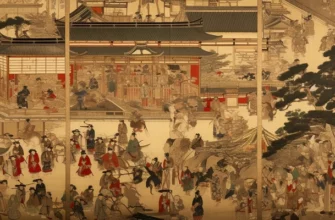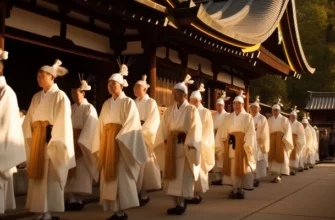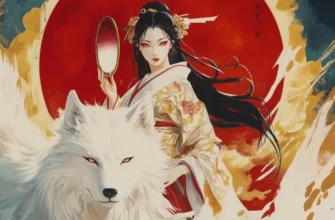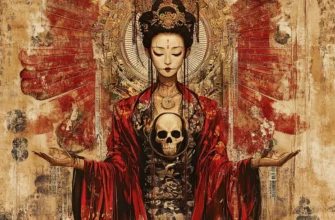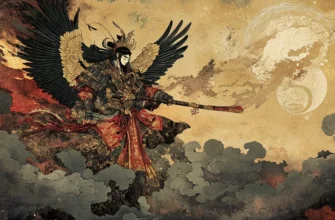Kagutsuchi, also known as Homusubi, is the Japanese god of fire, symbolizing destruction and rebirth. His story originates in Shinto mythology, where he was born from the divine creators of the world, Izanami and Izanagi. However, Kagutsuchi’s birth was a tragedy: due to his burning nature, his mother, the goddess Izanami, suffered fatal burns. In his anger, Izanagi killed his son, cutting him into pieces, from which new deities and natural elements were born.
Kagutsuchi embodies the two opposing sides of fire: the destructive force that brings death and chaos, and the creative energy that purifies and promotes rebirth. Fire has always been important in Japanese culture, being part of purification rituals and a symbol of the life cycle.
Today, the image of Kagutsuchi lives on in Japanese culture, particularly in art, literature, and modern media. His myths remind us that new life is often born from destruction.
- The origin of Kagutsuchi
- Mythological roots and the creation of the world
- Name and meaning
- Legends about Kagutsuchi
- The birth of Kagutsuchi: tragedy and first death
- Kagutsuchi and the emergence of natural forces
- The symbolic role of fire in rituals
- The tragedy of his birth
- The birth and death of Izanami
- Izanagi’s reaction: anger and revenge
- Kagutsuchi as a symbol
- Reflections in art and literature
- Conclusion
The origin of Kagutsuchi
Kagutsuchi, or Homusubi, is one of the key figures in Japanese Shinto mythology. His story begins with the creation of the world, when the goddess Izanami and the god Izanagi, the heavenly creators, gave life to the deities and natural phenomena.
Kagutsuchi was born as the god of fire, but his birth was a tragedy. When he came into the world, his burning flames caused fatal burns to his mother, Izanami. This event symbolizes the power of fire, which can both create and destroy. Izanagi, overcome with anger and grief, killed his son by cutting him in half with his sword. From the parts of Kagutsuchi’s body, other deities associated with the elements emerged, such as the god of mountains, the god of the seas, and the god of thunder.
Kagutsuchi embodies the duality of fire: its ability to destroy and at the same time promote rebirth. This concept plays an important role in Japanese culture, where fire is considered both a symbol of purification and a source of danger.
The myth of Kagutsuchi shows the complexity and multifaceted nature of the Japanese worldview, where destruction often precedes the creation of new life.
Mythological roots and the creation of the world
Kagutsuchi, the Japanese god of fire, plays a key role in the mythological story of the creation of the world. His appearance symbolizes the transition from creation to destruction, which is an integral part of the cycle of life.
Kagutsuchi was born as the last child of the gods Izanami and Izanagi, who had previously created the islands of Japan, the elements, and other deities. However, his birth was tragic: Kagutsuchi’s fiery nature burned his mother Izanami, causing her death. This was the first death in mythology, which changed the course of the world’s existence.
Izanagi, overcome with grief and anger, killed Kagutsuchi by cutting him in half with his sword. From the parts of the fire god’s body, new deities were born, which became the embodiment of natural forces such as mountains, water, thunder, and other elements. Thus, Kagutsuchi became a source not only of destruction but also of the creation of new life.
His role in mythology shows the duality of fire: on the one hand, it destroys, and on the other, it promotes purification and rebirth. In Japanese culture, this became the basis for purification rituals, as well as a symbol of the life cycle, where each ending becomes the beginning of something new.
The myth of Kagutsuchi embodies the idea of harmony between opposites — creation and destruction, life and death, which are the basis of the world order.
Name and meaning
The name Kagutsuchi (Japanese: 火之迦具土, also known as Homusubi, 火産霊) has a deep symbolic meaning associated with the element of fire.
Etymology of the name
The name “Kagutsuchi” consists of several parts:
“Kagu” (迦具) means “flame” or “bright glow.”
“Tsuchi” (土) translates as ‘earth’ or “clay,” but in the context of the name, it reflects something material and stable that can be the basis for creation.
The second name, “Homusubi,” translates as “the one who gives birth to fire,” emphasizing his role as a source of energy and heat.
The symbolism of fire
In Japanese mythology, fire, like Kagutsuchi, represents duality. It is destructive and life-giving at the same time:
Destruction: Kagutsuchi’s birth led to the death of his mother, symbolizing the danger and chaos that fire can cause.
Creation: After Kagutsuchi’s death, new deities emerged from his body, symbolizing rebirth and renewal through purification by fire.
In a cultural context, fire plays an important role in Shinto purification rituals. Flames are used to purify objects, territories, and even thoughts, which echoes Kagutsuchi’s image as a source of purification and rebirth.
Thus, the name Kagutsuchi reflects his essence—the power of fire to destroy the old in order to create the new—and serves as the embodiment of harmony between destructive and creative energy.
Legends about Kagutsuchi
Kagutsuchi, the god of fire in Japanese mythology, is the central figure in several legends that reveal his dual nature — destructive and creative. These myths reflect the Japanese understanding of the cycle of life, where destruction is the beginning of new creation.
The birth of Kagutsuchi: tragedy and first death
Kagutsuchi was born to the divine couple Izanami and Izanagi. However, his fiery nature caused the death of his mother — Izanami suffered fatal burns during childbirth. This event became the first death in Japanese mythology, introducing the idea of the end as part of existence.
Izanagi, overcome with grief and rage, killed Kagutsuchi with his sword, Tsurugi. After that, new deities symbolizing various natural forces, including mountains, rivers, and winds, emerged from Kagutsuchi’s blood and body parts.
Kagutsuchi and the emergence of natural forces
It is believed that Kagutsuchi’s death gave birth to important deities such as:
Oyamattsu-no-kami — god of mountains;
Kuraokami — deity of water and rain;
Kami of thunder and lightning.
Thus, the destruction caused by Kagutsuchi’s death became a source of creation, and his legacy was embodied in the natural elements that govern the world.
The symbolic role of fire in rituals
Kagutsuchi is also mentioned in legends about purification and rituals honoring fire. Fire was considered sacred and was used in purification rituals inspired by his myths.
The legends of Kagutsuchi embody the idea of the cyclical nature of life and death. They remind us that destruction is always accompanied by creation, and that every ending is the beginning of a new journey.
The tragedy of his birth
The birth of Kagutsuchi was one of the most tragic events in Japanese mythology. He was the last child of the divine couple who created the world, Izanami and Izanagi. His birth not only brought death to his mother, but also changed the course of the entire world.
The birth and death of Izanami
Kagutsuchi was born as the embodiment of fire, and his burning nature caused fatal burns to his mother, Izanami. In agony, she gave birth to several other deities associated with the elements, such as the gods of metal and water. However, her wounds proved fatal, and she departed for Yomi, the world of the dead.
This event marked the first death in Japanese mythology, introducing the concept of the end of life into the world of immortal gods.
Izanagi’s reaction: anger and revenge
Izanagi, overcome with grief and anger at the loss of his wife, killed Kagutsuchi. He used his sword, Tsurugi, to cut his son’s body in two. From Kagutsuchi’s blood and body parts, other deities were born, symbolizing the forces of nature — mountains, water, wind, and other elements.
The tragedy of Kagutsuchi’s birth shows the dual nature of fire: it is a source of life, purification, and creation, but it also brings death and destruction. Through this event, the idea that destruction can be a necessary condition for rebirth and the emergence of something new became established in Japanese mythology.
The tragedy of Kagutsuchi is an important symbol of the cyclical nature of life, which has become a central theme in Japanese culture and rituals.
Kagutsuchi as a symbol
Kagutsuchi, as a symbol of fire in Japanese mythology and culture, is an important image that combines two opposing but complementary forces: destruction and creation. This duality of fire as a deity has a profound meaning and reflects the nature of an element that cannot be completely controlled but can be used for good.
1. Fire as a destructive force
Fire is often associated with destruction in many cultures. In the myths about Kagutsuchi, fire is a powerful force capable of destroying everything in its path. It can burn forests, destroy buildings, and create chaos, bringing death and destruction. This symbolizes the danger of uncontrolled energy and the elements running wild, and shows how a powerful force can lead to undesirable consequences if not handled with care.
In this context, Kagutsuchi symbolizes the destructive side of fire, which can be used for purification but also has enormous potential for disaster if left uncontrolled.
2. Fire as a creative force
At the same time, fire in Japanese culture is not only destruction, but also an important symbol of creativity and renewal. Fire burns old materials, purifies, and makes room for the new. It becomes an essential element in the processes of transformation in which new life emerges. In myths, Kagutsuchi is often associated with the processes of birth, purification, and rebirth after destruction.
In Japan, fire is an important element in the processing of materials (such as ceramics or metals), and its role in creative processes is extremely important. Fire is capable of transforming matter, particularly in the creation of cultural objects that then have a profound meaning in people’s lives.
3. The duality of the symbolism of fire through Kagutsuchi
Kagutsuchi, as the deity of fire, embodies the balance between destruction and creation. On the one hand, fire can destroy and burn everything in its path. On the other hand, it purifies and provides an opportunity for new growth and a new beginning. This image of fire as a dual force is present in many Japanese rituals and philosophy, where fire is used as a symbol of purification, renewal, and new opportunities.
Kagutsuchi is also an example of how, in the Japanese worldview, the elements — fire, water, earth, and air — have a balancing role, and each can act as a force for creation or destruction depending on the context and circumstances.
Thus, Kagutsuchi as a symbol of fire is not only a danger but also an important source of energy and power for rebirth, evoking a deep understanding of the nature of life and the cyclical processes on Earth.
Reflections in art and literature
Kagutsuchi, as a fire deity, is of great importance in Japanese art and literature, where he symbolizes both the destructive and creative power of fire. His image is reflected in various genres, from classical literary works to contemporary artistic expressions. Fire and its symbolism in art become part of profound metaphors and images that convey struggle, purification, rebirth, and transformation.
1. Art (painting, ceramics, sculpture)
In traditional Japanese art, fire often symbolizes purification and transformation. Although Kagutsuchi himself is not always depicted directly, his symbolism and association with fire are reflected in works of art through images of flames, tongues of fire, or burning objects.
Painting: In Japanese painting, you can find images of fire as an element that engulfs landscapes or scenes, where fire is a symbol of purification or disaster. In particular, the Japanese genre of ukiyo-e (Japanese woodblock prints) often uses fire motifs, although this is more related to events such as large fires than specifically to Kagutsuchi. In such works, flames can have a dual role: on the one hand, they are a destructive force, and on the other, they represent the possibility of new life and change.
Ceramics and sculpture: In traditional Japanese ceramics, fire is an important part of the process of making ceramic products. Fire, like Kagutsuchi, plays the role of a creator, because it is through fire that perfect works are produced. Statues depicting various deities, which may be made using fire in the process of their creation, are worth mentioning separately.
2. Literature
In Japanese literature, the image of fire, and therefore Kagutsuchi, appears in numerous myths, poetry, and contemporary works, where fire often symbolizes dramatic moments in the lives of heroes — purification, struggle, death, and rebirth.
Mythology and classical literature: In classical Japanese literature, particularly in the Kojiki (a collection of Japanese myths and stories), there are tales about Kagutsuchi and his role in the creation of the fire element. The dual nature of fire is often emphasized here: its destructive power that causes death, as well as its creative power that brings new opportunities and life. Accordingly, fire in Japanese mythology is a means of purification and rebirth.
Poetry: In Japanese poetry, fire is often associated with emotions and inner experiences. The famous Japanese poet Matsuo Basho, founder of the haiku genre, used images of fire to reflect the changeability and transience of life. Fire also appears in other forms of Japanese poetry, such as tanka, where it can symbolize the flames of passion, anger, or purification through hardship.
Contemporary literature: In contemporary Japanese literature, fire is often associated with the concept of inner conflict, purification through suffering, or even the destructive power of war. For example, in the works of Haruki Murakami or Yoko Ogawa, you can see metaphors that combine fire and the inner world of the characters. Fire in these works sometimes symbolizes the struggle between the dark and light sides of human nature, similar to how Kagutsuchi represents an element that simultaneously destroys and gives new life.
3. Movies and anime
Fire and its symbolism are also common in Japanese movies and anime, where it can be part of heroic moments or dramatic situations. In modern Japanese anime and manga, fire is often depicted as a powerful force that the characters must deal with.
In some anime, such as My Hero Academia, some characters have the ability to control fire, which can be a metaphor for inner struggle or willpower. This is a modern reflection of myths about fire and deities such as Kagutsuchi, where the element of fire becomes a symbol of struggle and transformation.
4. Kabuki Theater
In traditional Japanese kabuki theater, there are numerous productions depicting heroic or tragic scenes where fire appears as a symbol of struggle or purification. Although fire itself is not always a figure, it is an important part of the scenery and symbolism. The image of fire blazing on stage can symbolize not only drama, but also the transformation of characters through trials.
5. Iconography
In Japanese temples and shrines, you can see iconography depicting deities associated with fire, including Kagutsuchi. He is sometimes depicted as a young man surrounded by flames or as a force enveloping certain sacred objects. This personifies the connection between deities and fire as a symbol of purification, protection, and life-giving power.
Kagutsuchi as a symbol of fire is reflected in Japanese art and literature as a powerful and multifaceted force that combines destruction and creation. His image can be found in numerous cultural forms, from myths and poetry to modern anime and cinema, where fire is an important motif for conveying emotions, inner conflicts, and processes of transformation.
Conclusion
The Japanese god Kagutsuchi is an important deity in Japanese mythology and culture, and his significance is closely linked to fire, which symbolizes both destructive and creative power. As the god of fire, Kagutsuchi embodies the duality of this element — the ability to destroy and purify, as well as to revive and create. His role in Japanese myths and rituals reflects a deep understanding of the nature of the elements and the need to balance them to maintain harmony in the world.
In Japanese mythology, Kagutsuchi is associated with other deities, such as the son of Izanami and Izanagi, and also symbolizes the balance between life and death, as fire burns everything but also promotes rebirth through purification. Fire, like Kagutsuchi himself, is an important element of Shinto religious rituals and cult practices. It is often used for purification, burning old amulets or objects associated with impurity, and as part of many festivals, where it symbolizes protection and prosperity.
In Japanese art and literature, Kagutsuchi and fire as a symbol are depicted in numerous works, where they often become metaphors for inner conflict, struggle, purification, and rebirth. Fire in Japanese poetry, anime, and theatrical performances symbolizes not only physical strength but also deep emotional and psychological processes. In modern Japanese culture, the symbolism of Kagutsuchi and fire continues to play an important role in films, anime, and manga, where fire is often associated with the emotions of the characters, their struggle against adversity, and their desire for self-renewal.
Thus, Kagutsuchi not only symbolizes the element of fire, but also reflects the deep philosophical ideas of Japanese culture about struggle, purification, transformation, and rebirth. It is an important element of Japanese mythology, religion, and art, emphasizing the complexity and multifaceted nature of human experiences and interactions with natural forces.
